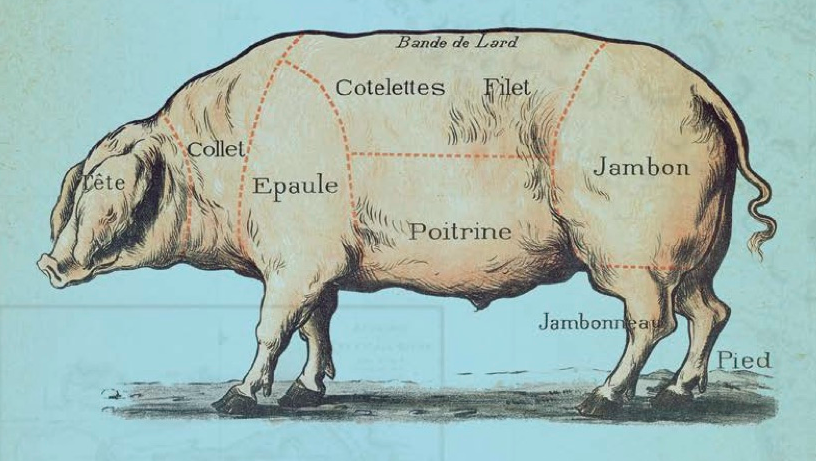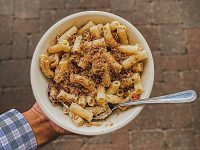Country’s Leading Hog Historian Comes to Camp Bacon®
I first met Mark Essig while I was speaking in Asheville. I’d done some ZingTrain work for our long-time client Laurey Masterton, who sadly passed away a few years ago. We still miss her. Laurey had arranged on that trip for me to do a dinner around the then recently released Zingerman’s Guide to Better Bacon. As part of the brief, bacon-based talk I did for the dinner guests, I referenced one of my favorite learnings from the research I’d done for the book. I’m fascinated by professions that no longer exist. Ice harvesting is one of them. Another is droving. It’s so obscure you’ve likely never heard of it. But up until the advent of the railroads in the second half of the 19th century, it was the process to get hogs from the small farms where they were raised—usually only a handful per farm—to the city where they could be slaughtered to provide pork to the nation’s growing urban population. Since the pigs weren’t going to make the journey on their own, they needed the porcine equivalent of a chaperone. The men who did that were known as drovers.
In the moment, the point of this story is that wherever I went to present on bacon, I’d tell the story of the drovers. Not surprisingly, barely a soul had ever even heard of them. Not shocking given that they’d been essentially extinct for well over a hundred years. Anyway, when I spoke in Asheville that winter’s evening, a tall guy, to my right, raised his hand and mentioned to me that he was very interested in the drovers! He was doing research and wanted to share information. Excited to find someone else who was interested in obscure history, I invited him to speak at the spring’s Camp Bacon®. It was our second annual gathering, then as now, a fundraiser for the Southern Foodways Alliance and Washtenaw County 4H. Andre Williams came and played his marvelous 1956 hit single, Bacon Fat, that year (look it up online—it’s a great piece of music!). Mark came as well and gave a fantastic talk on the drovers.
Five years or so later, Mark’s research hit the bookshelves. Lesser Beasts; A Snout-to-Tail History of the Humble Pig is a fantastic piece work on the history of the pig, from prehistoric times all the way through to the present. It’s well-researched, well-written, and super informative. As you probably know, I’ve been paying close attention to culinary history, and pigs in particular, for over three decades, and I learned a LOT from it. If you like to read, you’re intrigued by pork and love to learn, add it your list ASAP. It’s a great Mother’s or Father’s Day gift for any pork-loving parents in your life. To add a little outside credibility to support my claim, the Atlanta Journal-Constitution called Lesser Beasts, “Splendid…Essig surveys the 10,000 year partnership of man and pig, a tumultuous affair full of accusation, fire and litigation… A pleasure to read.”
To whet your appetite, check out the excerpt below. It’s a just small piece of the book but it’ll hopefully pique your curiosity. If you’re really intrigued, Mark will be presenting at this year’s main event for the 7th Annual Camp Bacon® on Saturday June 4th. He’ll also be speaking at the Thursday evening Bacon Ball (June 2nd), our annual pork-focused special dinner at the Roadhouse.
Oh yeah, if you want read more about the drovers, you can also grab a copy of the Zingerman’s Guide to Better Bacon as well. A couple of good books and some good bacon can be a marvelous way to spend a nice spring day!
![]()
MARK ESSIG, AUTHOR OF THE AMAZING LESSER BEASTS; A SNOUT-TO-TAIL HISTORY OF THE HUMBLE PIG TO PRESENT AT 7TH ANNUAL PORK FEST

Excerpted from Lesser Beasts: A Snout-to-Tail History of the Humble Pig by Mark Essig. Available from Basic Books, a member of The Perseus Books Group. Copyright © 2015.
An enormous pig, belly up, is wheeled into a banquet room in one scene of Federico Fellini’s Satyricon. Trimalchio, the host, accuses the cook of roasting the animal without first gutting it and orders him whipped as punishment. The guests call for mercy, so Trimalchio demands, “Gut it here, now,” where upon the cook swings an enormous sword and slashes the pig’s belly. The guests recoil in horror, but the steaming mass that pours forth is not the pig’s viscera but cooked meat. “Thrushes, fatted hens, bird gizzards!” one character calls out. “Sausage ropes, tender plucked doves, snails, livers, ham, offal!” The dispute with the cook has been all in fun. The guests applaud, then grab hunks of meat and begin to gorge themselves.
Fellini’s film, released in 1969, stays true to its source material, a work by Petronius written not long after the death of Christ. In depicting Roman dining, Petronius satirized but did not exaggerate: there was no need to embellish the extravagant reality. The dish portrayed in the film, a medley of meats hidden within a whole hog, was known as porcus Troianus, or “Trojan pig,” a nod to another great act of concealment. Petronius also describes a whole roast pig served with hunks of meat carved into the shape of piglets and placed along its belly, “as if at suck, to show it was a sow we had before us.” Another feast featured what appeared to be a goose and a variety of fish, all carved from pork. “I declare my cook made it every bit out of a pig,” the host exclaims. “Give the word, he’ll make you a fish of the paunch, a wood-pigeon of the lard, a turtle-dove of the forehand, and a hen of the hind leg!” Why he should do so is left unexplained.
In cuisine, culture, and mythology, Romans delighted in concealment and disguise, metamorphosis and transformation, and in this they could hardly have been more different from the Jews. The Roman Empire formed a vast, cosmopolitan civilization that embraced and absorbed dozens of cultures. Few identities— whether of meats or of people—remained fixed. Trimalchio, in Satyricon, is a former slave who has won his freedom and then attained great wealth. A man calling himself a Roman citizen might have been born in northern Europe, Africa, or Asia Minor. Jews, by contrast, were dedicated to marrying among themselves, defending their small homeland, and preserving their ancient ways.
The differences between Romans and Jews extended to food. One people defined itself by rejecting pork, the other by embracing it. One called the pig abominable, the other miraculous. One saw the pig as a carrier of pollution, the other as a sign of abundance. Between them, Jews and Romans set the terms that would define the pig throughout the history of the West.
Most people in the ancient world ate vegetarian diets heavy on grains and beans. This was the cheapest way to feed large populations. Rome was different. Although meat was expensive, Rome was rich, and a sizable class of people had enough money to eat it regularly.
Romans ate beef, lamb, and goat, but they preferred pork. Hippocrates, the Greek physician, proclaimed pork the best of all meats, and his Roman successors agreed. There were more Latin words for pork than for any other meat, and the trade became highly specialized: there were distinct terms for sellers of live pigs (suarii), fresh pork (porcinarius), dried pork (confectorarius), and ham (pernarius). According to the Edict of Diocletian, issued in 301 A.D., sow’s udder, sow’s womb, and liver of fig-fattened swine commanded the highest prices of any meat, costing twice as much as lamb. Beef sausages sold for just half the price of pork. After the Punic Wars, the percentage of pig bones in Carthage doubled, just as it had in Jerusalem under Roman occupation: Romans kept eating pork even in arid climates such as North Africa and Palestine, where pigs were more difficult to raise.
The richest source on Roman cuisine, a recipe book known as De re coquinaria, or On Cooking, confirms this love of swine. Pork dishes far outnumber those made with other meats. The section called “Quadrupeds” contains four recipes for beef and veal, eleven for lamb, and seventeen for suckling pig. Other sections of the book offer recipes for adult sows and boars and nearly all of their parts, including brain, skin, womb, udder, liver, stomach, kidneys, and lungs. Archeology confirms that Romans carved up pigs more carefully and thoroughly than they did other creatures: pig skulls found in Roman dumps contain far more butchery scars than the skulls of sheep and cows, evidence that butchers excised the tongues, cheeks, and brains of pigs but not those of other beasts.
More than half of the dishes in On Cooking are relatively modest—barley soup with onion and ham bone, for example— and within the means of much of the urban population, but others demanded greater resources. Apicius is credited with inventing the technique of overfeeding a sow with figs in order to enlarge the liver, much as geese were stuffed with grain to create foie gras. In Apicius’s recipe, the fig-fattened pig liver is marinated in liquamen—a fermented fish sauce central to Roman cuisine— wrapped in caul fat, and grilled. The recipe for pig paunch starts with this salutary advice: “Carefully empty out a pig’s stomach.” The cook is then instructed to fill the stomach with a mixture of pork, “three brains that have had their sinews removed,” raw eggs, pine nuts, peppercorns, anise, ginger, rue, and other seasonings. Finally, the stomach is tied at both ends—“leaving a little space so that it does not burst during cooking”—boiled, smoked, boiled some more, and then served.
Some of the more elaborate dishes in On Cooking fall under the heading ofellae, which literally means a morsel of food. In one recipe, a skin-on pork belly is scored on the meat side, marinated for days in a blend of liquamen, pepper, cumin, and other spices, and then roasted. The chunks of meat would then be pulled from the skin, sauced, and served, forming bite-sized pieces that a diner could eat by hand while reclining, the preferred posture for Roman feasts. Another of the luxury dishes involves boiling a ham, removing the skin, scoring the flesh, and coating it with honey, a preparation that would not be out of place at Christmas dinner today.
Romans had a taste for blended milk, blood, and flesh that could make even a Gentile shudder. The Roman poet Martial had this to say about a roasted udder of lactating sow: “You would hardly imagine you were eating cooked sows’ teats, so abundantly do they flow and swell with living milk.” (Elsewhere, after a meal, Martial suffers the glutton’s regret and remarks upon “the unsightly skin of an excavated sow’s udder.”) This preference veered into the bizarrely cruel. Some cooks, Plutarch claimed, stomped and kicked the udders of live pregnant sows and thereby “blended together blood and milk and gore,” which was said to make the dish all the more delicious. The womb of this poor sow was eaten as well, with the dish called vulva eiectitia, or “miscarried womb.”
Seneca, the Stoic philosopher and statesman, decried such dishes as “monstrosities of luxury,” and he was far from the only critic. Roman rulers passed sumptuary laws limiting the amount that could be spent on meals and forbidding the consumption of items including testicles and cheeks. But the wealthy flouted such rules because the social hierarchy couldn’t function without feasts: feasting provided the only way to learn who had grown richer and who had lost money, who was in the emperor’s favor and who had been cast out. To curtail extravagance was to deny the very reason to feast.
…
Rome created the most sophisticated agricultural system the world had ever known. Previously, farming had been a local affair. Even in the great civilizations of Egypt and Mesopotamia, production and consumption occurred within a fairly circumscribed area defined by irrigated river valleys and surrounding rangeland. By contrast, imports from outside the Italian Peninsula constituted three-quarters of Rome’s food supply.
Rome brought all of the Mediterranean world and much of Europe within its orbit, pulling in grain from Egypt, cured meats from Spain, olive oil from Syria, and spices from further east. The wheat that satisfied Caesar’s bread dole was mostly imported from North Africa, where it was collected as tax. Grain sufficient to feed hundreds of thousands of people moved around the region by ship and filled large granaries that provided insurance against famine.
Although Romans imported grain by ship, they raised nearly all of their livestock within Italy. They kept sheep primarily for wool and secondarily for milk and cheese. Goats were rare, though sometimes raised for milk. Cows offered dairy products, and oxen pulled plows in the fields and carts on the road. Meat from these animals was eaten, but it was usually a by-product rather than the principal reason for raising them. Archaeologists tell us that most butchered cattle show stress injuries to their leg bones, meaning that they worked hard before ending up in the pot. Beef and mutton came from older animals—ewes and cows whose udders had dried up, rams and bulls who had become infertile, and oxen that could no longer pull a plow.
Only pigs were raised exclusively for food. They were eaten when young and therefore were far more tender than worn-out oxen. A popular saying held, “Life was given them just like salt, to preserve the flesh”—meaning that pigs had no reason for living other than to feed people. Given how much Romans loved to feast, this was no small consideration. According to Varro, Rome’s most important agricultural writer, “the race of pigs is expressly given by nature to set forth a banquet.”




Zingerman’s Art for Sale